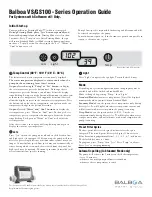
valve on the solar return line above the tee, with the direction of ow going into the tee.
Most accessories including auxiliary heaters, chlorine feeders, Pool cleaner pumps should
be on the return line after the tee. Automatic pool cleaner pumps must be run at night when
the solar is o or during the day only after the solar is already running. Failure to do so may
result in a burnt-out cleaner pump.
11. Pipe Layout
Use 2” Schedule 40 PVC plastic piping between the bottom end plumbing and the panels. White
pipe is recommended because of its excellent outdoor life. The pipe may be painted with a good
outdoor paint to match the structure or roof. 1½” pipe may be used on splits between panel rows.
All plumbing should allow for gravity drain. In tropic or sub-tropic climates, the panels and plumb-
ing may be level; in northern climates, they must be installed with a ¼” per foot slope towards
the pool equipment. The panels should gravity drain back to the pool. If it is not possible to route
plumbing to allow for panel drainage, a manual drain valve or line should be installed, or the end
plugs may be removed to drain panels. Support all pipes every 4’ using 2½” Galvanized Pipe Clamps.
12. Control Installation
12.1 Solar Controls
Several types of solar controllers are available. The most common utilize a 3-way diverter valve (see
fi gure 32) todivert water from the normal fi lter loop to the solar panels. Other models use a 2-way
valve (see fi gure 31) to blockwater from the normal fi lter loop, forcing it through the solar panels.
Both 3-way and 2-way are currently available inautomatic or manual versions. Some automatic sys-
tems have a manual over-ride which allows manual operation ofthe valve without electrical power.
Fig (31): Manual Control
Fig (32): Automatic Control
25
Solar Pool System
Installation Manual








































